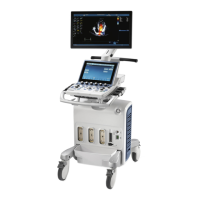D
IRECTION FR091521, REVISION 1 VIVID S60N/VIVID S70N BASIC SERVICE MANUAL
10-16 Section 10-3 - Why Perform Maintenance Procedures?
PRELIMINARY
The electrical safety tests in this section are based on NFPA 99 Standard for Health Care Facilities and
IEC 62353 Medical electrical equipment – Recurrent test and test after repair of medical electrical
equipment. These standards provide guidance on evaluating electrical safety of medical devices which
are placed into service and are intended for use in planned maintenance (PM) or testing following
service or repair activities. They differ somewhat from the standards that are used for design verification
and manufacturing tests (e.g., IEC 60601-1 and UL 60601-1) which require a controlled test
environment and can place unnecessary stress on the Ultrasound system.
These tests may refer to specific safety analyzer equipment as an example. Always refer to the safety
analyzer’s user manual that will be used to perform the tests.
• Check for missing or loose enclosure covers that could allow access to internal live parts.
• Examine the mains cord, mains plug and appliance inlet for damaged insulation and adequacy of
strain relief and cable clamps.
• Locate and examine all associated transducers. Inspect the cables and strain relief at each end.
Inspect the transducer enclosure and lens for cracks, holes and similar defects.
Prior to initiating any electrical test, the Ultrasound system must be visually inspected. Perform the
following visual checks:
Equipment users must ensure that safety inspections are performed whenever damage is
suspected and on a regular basis in accordance with local authorities and facility procedures.
Do not use the Ultrasound system or individual probes which fail any portion of the safety test.
10-6-3 Leakage Current Limits
The following acceptance limits and test conditions are summarized from NFPA 99 and IEC 62353 and
in some cases are lower than that specified by the standards.
In accordance with these standards, fault conditions like Reverse Polarity of the supply mains and Open
Neutral are no longer required for field evaluation of leakage current. Because the main source of
leakage current is the mains supply, there are different acceptance limits depending on the
configuration of the mains (100-130 or 220-240).
Leakage current limits for Vivid ultrasound systems are shown in Table 10-11 for 100-120 Volt and
230-240 Volt mains.
NOTE: Open Grounding is also known as “Lift Ground”.
Energy Control and Power Lockout for Vivid™ S60/Vivid™ S70.
When servicing parts of the Ultrasound system where there is exposure to voltage greater
than 30 volts:
1. Follow LOCK OUT/TAG OUT procedures.
2. Turn off the breaker.
3. Unplug the Ultrasound system.
4. Maintain control of the Ultrasound system power plug.
5. Wait for at least 30 seconds for capacitors to discharge as there are no test points to
verify isolation.
6. Remove/disconnect the battery, if present.
Ultrasound System components may be energized.
Compare all safety-test results with safety-test results of previously performed safety
tests (e.g. last year etc.). In case of unexplainable abrupt changes of safety-test results
consult experienced authorized service personnel or GE for further analysis.

